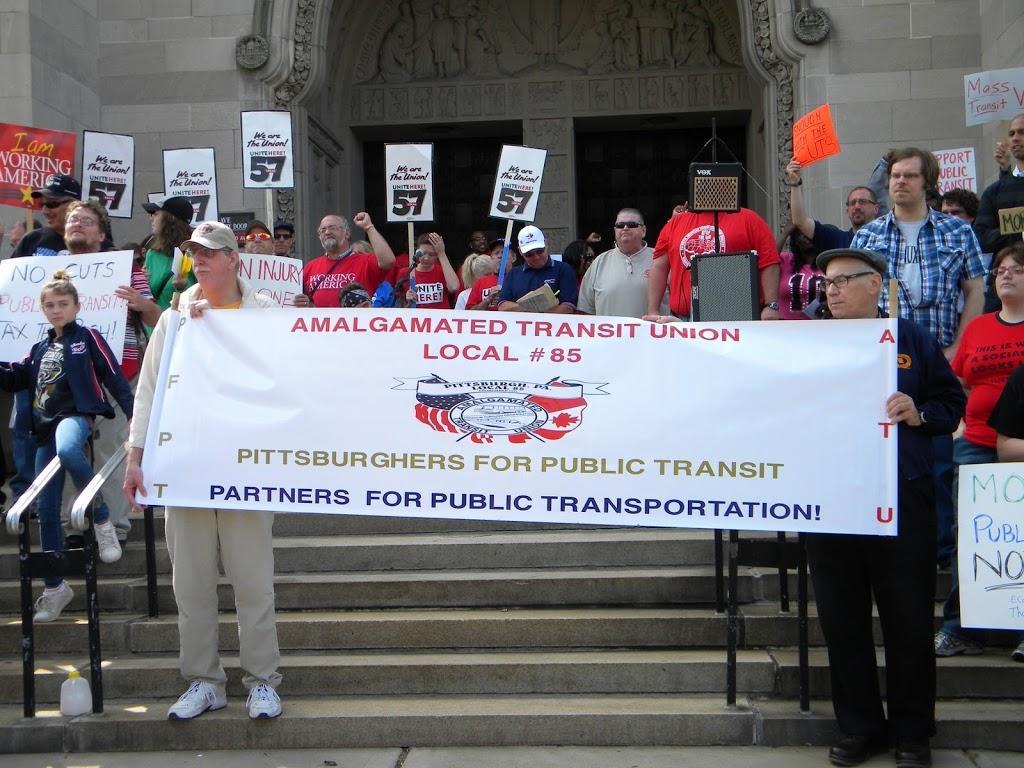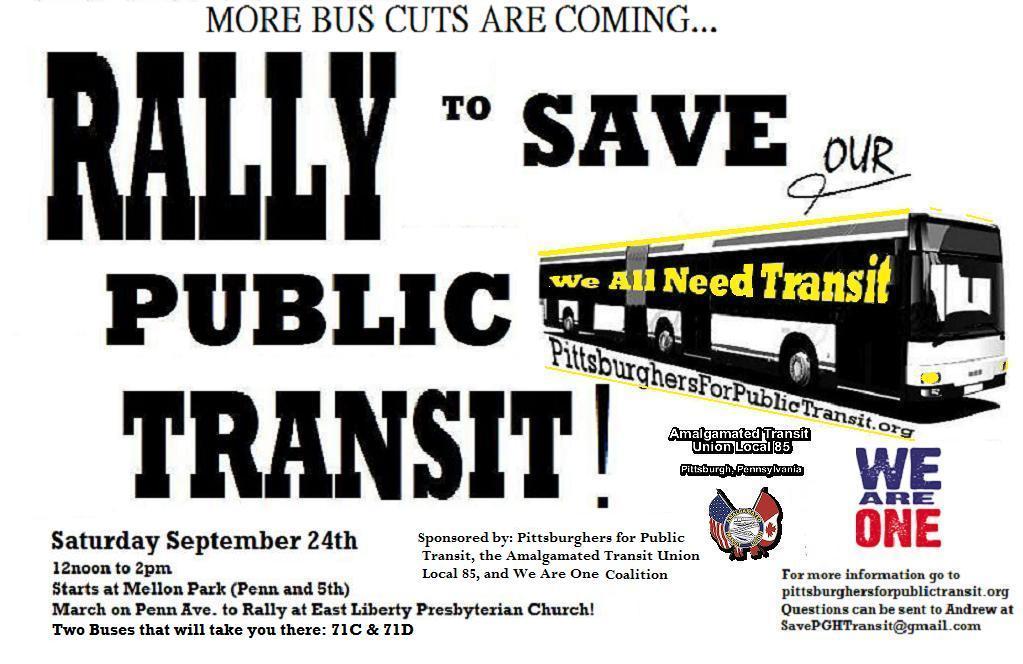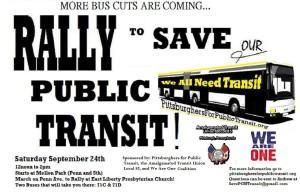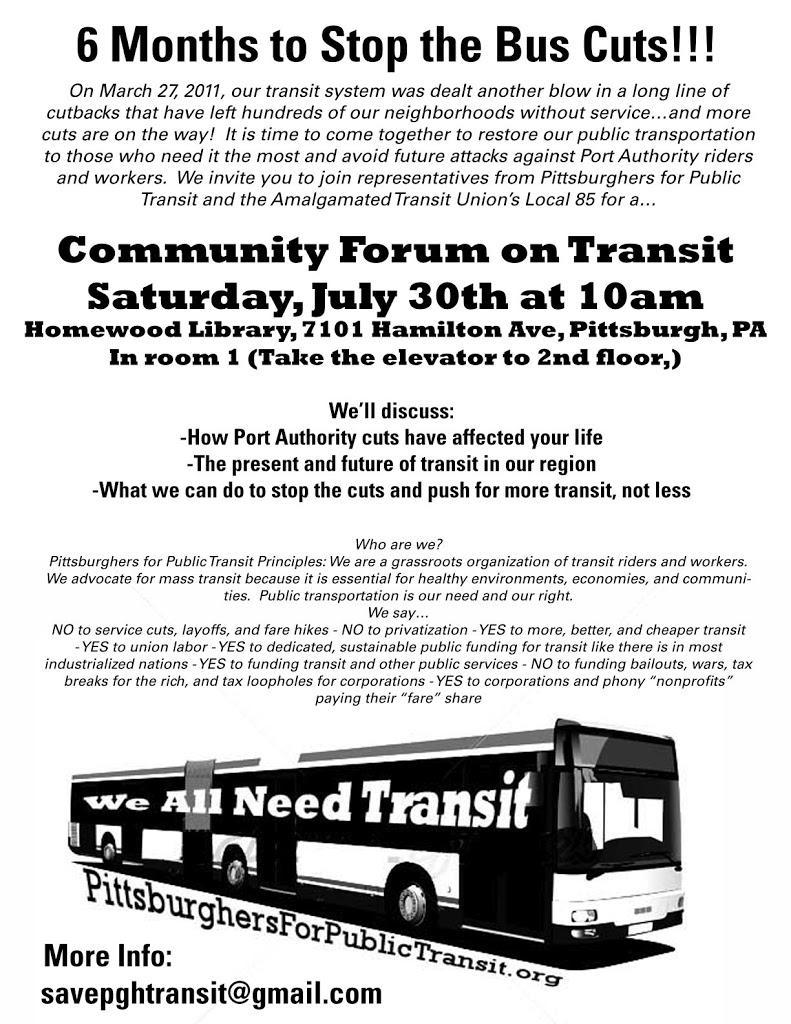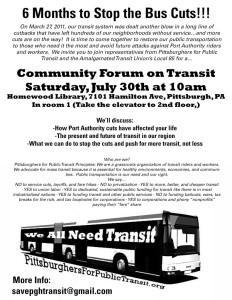 |
| Marchers rallying on the steps of East Liberty Presbyterian Church |
|
|
|
|
|
|
|
|
|
|
|
|
|
|
|
|
|
|
|
|
|
|
|
|
|
|
|
|
|
|
|
|
|
|
|
|
|
|
|
|
|
|
|
|
|
|
|
|
|
|
|
|
|
|
|
|
|
|
|
|
|
|
|
|
|
|
|
|
|
|
|
|
|
|
|
|
|
|
|
|
|
|
|
|
|
|
|
|
|
|
|
|
|
|
|
|
|
|
|
|
|
|
|
|
|
|
|
|
|
|
|
|
|
|
|
|
|
|
|
|
|
|
|
|
|
|
|
|
|
|
|
|
|
|
|
|
|
|
|
|
|
|
|
|
|
|
|
|
|
|
|
|
|
|
|
|
|
|
|
|
|
|
|
|
|
|
|
|
|
|
|
|
|
By Jonna Jamie
Pittsburgh, PA- On September 24, 2011 200 Pittsburghers marched down Penn Avenue through the neighborhood of East Liberty demanding “more transit, not less” and “no more cuts” to the bus routes in Allegheny County and beyond. The march and rally was organized by Pittsburghers for Public Transit (PPT) and endorsed by the Amalgamated Transit Union (ATU) Local 85, amongst others. The people in attendance were diverse but the message was a focused one. The crowd was a mix of ages, creeds and skin colors. PPT’s slogan rang visually true: we all need transit.
The march ended at East Liberty Presbyterian Church, where the marchers and onlookers gathered to show their energy and listen to speakers. Andrew Wagner of PPT kicked off the rally by saying “If they can cut the guts out of the postal service nationally, just imagine what they can do to transit in Allegheny County. This is a class war against working class people in this country. We need not to rely on Republican and Democrat votes, but on our own strength.”
William Anderson of The Black Political Empowerment Project followed Mr. Wagner’s theme, stating “This is a class issue. This has nothing to do with race, gender, creed… it is a war on poor people. We will not stand for this class attack where the rich are getting richer and the poor are getting poorer.”
“On Thanksgiving in 2010, we woke up to see in the newspaper that the Allegheny County Port Authority cut transit 40 percent,” said Pat McMahon, President of the ATU Local 85. “ Dan Onorato and the Board of Directors cannot deny any longer that this is a war against working people. That is the politics of Allegheny County and the democrats we voted for. It is class warfare brothers and sisters, and we need to do something about it…are you with us?” Mr. McMahon represents 22,000 Allegheny County transit workers.
“We need to go down to the garage and not let any of those buses roll out until they all can roll out,” said Jim Bonner, a laid-off bus driver who has taken to organizing since his layoff in March.
On March 27, cuts eliminated 29 routes, trimmed service on most others and threw 180 union workers out of their jobs. According to Port Authority figures released on June 15, ridership for April and May was off by 9.5 percent compared with April and May 2010. “This is not unique to Pittsburgh,” said Antonio Lodico of Western Pennsylvania’s We Are One Coalition. “Right now all over the country they [the rich] are attempting to destroy public gain for private good.”
Some in attendance view the transit issue as an opportunity to push for a political campaign. “We [working people] are fighting with one hand tied behind our backs and we need to form a labor party. One that is built by and for working people,” said Karl Belin of the Campaign for a Mass Party of Labor.
“Pittsburgh is currently trying to establish itself as a “green city,” leading the way in innovative environmentally-friendly jobs, technologies, and policies,” posts PPT on their website. “Cuts to public transit would be a major step back in these efforts… we should fund the Port Authority in order to lead the way in green initiatives that benefit our environment and health by improving our air quality and reducing run-off pollution to our water supply. Increased funding would allow Port Authority to expand their hybrid fleet and further experiment with biodiesel fueling options. Public transportation infrastructure and innovation are keys to the sustainable development and general well-being of our region.”
Other speakers included Carol of Pittsburgh Interfaith Impact Network, Tony Spadaro of the Pittsburgh chapter of Students for a Democratic Society, and a musical performance by Mike Stout, one of Pittsburgh’s working class rock stars. Mr. Stout’s localized version of Florence Reece’s “Which Side Are You On?” was a crowd pleaser.
